We are no longer building saddle trees, but we have two videos about how Western saddles fit horses available on our westernsaddlefit.com website.
Measuring Horses for Fit
Why to measure
Right off the top, we want to make it clear that we don’t build trees to fit just one horse. We build trees to fit a body type - and every horse (unless they have been damaged in some way) fits into a body type. The idea that if you get a saddle to fit one horse you have to shoot the saddle when the horse dies is NOT what we want to promote. As explained in the Factors That Affect Tree Fit article, a well designed tree will fit a range of horses. The horse in the middle of the range will be fit the best but the leeway we have due to the design of our bars and the large amount of surface area on them allows the saddle to be used comfortably on horses on both sides of that “ideal”. So when we give instructions on various methods of measuring a horse to determine fit, all we are trying to do is find a way to communicate the body type without us having to physically see the horse.
When to measure
We in no way require measurement of horses. We have built hundreds of trees based on verbal descriptions or according to specs given us by saddle makers. But for people who have never seen one of our trees or had a chance to throw it on a few horses and therefore don’t know what to order, for a maker who is dealing with a horse who is different than the type he is used to, or for an individual horse owner who wants to be sure to do everything they can to get what they want and need when ordering a saddle, these types of measurements help us all. It is important to measure the horse in their normal working shape. If they are normally fit, measuring when they are fat will give different results. If they are normally fat, then that is when you measure them!
How we use the measurements
We do NOT make our bars the inverse shape of the back drawings or the Dennis Lane (DL) cards. That would change the shape we build into our bars for edge relief and freedom of movement. Over the years we have tried trees on lots of horses, figuring out what specs fit best for that body type. When we initially got the DL system, we took the cards and some different trees out and tried them on a bunch of horses. We first measured the horses according to Dennis’ instructions and then tried on our trees as we normally would have to decide the best fit. By doing this, we learned that for X, Y, and Z DL numbers, we would use A, B and C of our specs to fit the way we like a tree to fit. So now, when we are told what shapes match the horse the best, we know what body type that represents and which of our specs we want to use to fit that type of horse. (You can read more about how we use the cards here on our blog.) We use back drawings in the same manner. The pictures give us additional information on size, symmetry, etc. that we take into account when making our decisions.
Unusual shapes of horses
We have found that a lot of horse owners think their horse is very unusual and hard to fit when in fact they fit nicely into the common body types (though maybe not the most common “saddle sizes”). On the other hand, some owners of horses with severe atrophy, asymmetry, etc. are unaware that their horse needs additional help. If we get information on a horse that is obviously abnormal or off the end of the bell curve of horse shapes, we will talk with our customer to determine what can best help this horse and owner, whether that be medical help, special pads, etc. This is generally the best solution for these horses and owners. We will not make an asymmetric tree or one that is so weird that it does need to be shot with the horse.
Methods of communicating body shape
The easiest way we know of is the Dennis Lane Equine Back Profiling System. Dennis Lane is an Australian saddle maker who also started building trees in 1992. Over the years as he collected hundreds of back drawings of horses, he started to notice patterns in them. So he made cards of different shapes, based on the back drawings of real horses, which are placed in specific places on a horse’s back. His cards are basically systematized back drawings. You just find the shape that fits the horse in that spot, note what shape it is and tell us the numbers. Since we have the same shapes here, we know what shape the horse is. You can also take your own back drawings as instructed below. We have revised our instructions to fall in line with the DL system which is much more consistent than the method we have used before. In either case, it is really helpful when pictures are sent to us so we can see where the cards or drawings were taken and to give us an image of the horse overall. The more information we have, the better.
Instructions for Taking Pictures
Have the horse stand as squarely as possible on as flat a surface as possible, with his head straight forward and at its normal working height. Take pictures of the horse without any additional markings as described below. Then take pictures with the lines or tape in place (see below). Tape often allows us to see the curves much better than just a picture of the horse does.
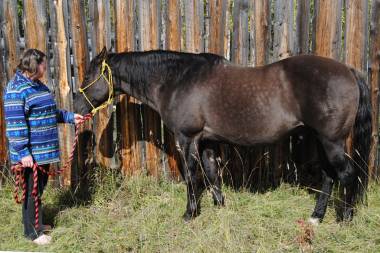
1.) Take a picture straight from the side, with the horse's head in its normal working position, preferably with a person or something in it to help us judge the size of the horse. This picture gives the best information about wither height, the relative positions of the withers and the shoulder, and whether the horse is built downhill or more level.
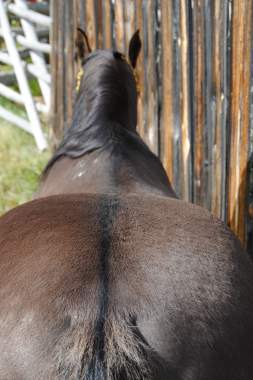 2.) Take a picture from directly behind and above the horse. Since you can have the same shape on a small, round horse as you do on a big round horse, this lets us see the width of the body as well as the twist along the sides. It also lets us see if there is substantial asymmetry between the sides. Try to keep the mane as far forward as possible to allow us to see the shoulders better.
2.) Take a picture from directly behind and above the horse. Since you can have the same shape on a small, round horse as you do on a big round horse, this lets us see the width of the body as well as the twist along the sides. It also lets us see if there is substantial asymmetry between the sides. Try to keep the mane as far forward as possible to allow us to see the shoulders better.
3.) Take a picture angled from the front on each side. This gives the best information about rock.
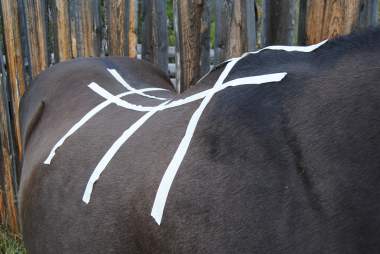 |
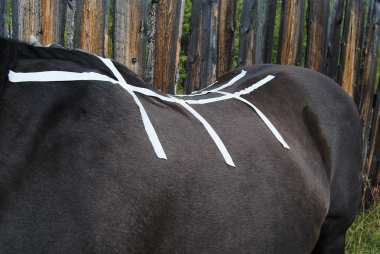 |
4.) Take a picture angled from the back on each side. This shows the prominence (or lack of prominence) of the shoulder blades the best.
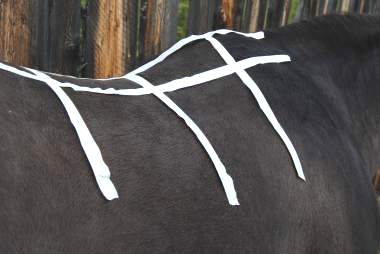 |
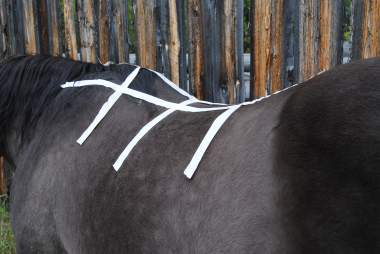 |
Instructions for Using the Dennis Lane Equine Back Profiling System
Note: Click here if you prefer a video explanation of how to use the Dennis Lane system.
1.) Have the horse stand as squarely as possible on as flat a surface as possible, with his head straight forward and at its normal working height when the measurements are taken. Standing with a hip cocked or a turned, raised or lowered head can change your results.
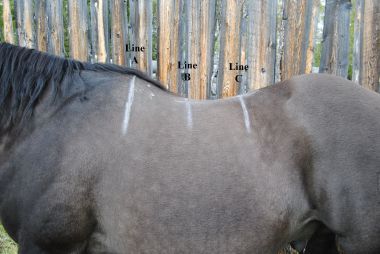
2.) Make three lines across the horse with chalk or tape to mark where the measurements are taken and to help reference those places to the topline. Line A should be taken just behind the back of the shoulder blade. Make sure you can feel the back of the shoulder blade and that your drawing is behind, and not over top, the shoulder blade. Line B should be placed at the lowest point of the horse’s back and Line C should be placed 8 inches behind Line B.
3.) Place one of the A cards on the horse at line A. Turn the card around and try each shape till you find the one that fits the best. Then double check by trying the size larger and the size smaller. Make sure you check on both sides, especially at A, to see if the same shape fits both sides equally well. Take pictures with the card in place. This lets us see not only where the cards are placed but what sections of the card may be lifting off the horse and what sections fit well. If you have problems deciding between two shapes, send us pictures of both. The point isn’t to classify your horse, but to communicate his shape to us. Because we build our trees to fit a range of horses, we do not use different specs for every different DL shape. It is the combination of all the card numbers which helps us determine which combination of our specs we will use.
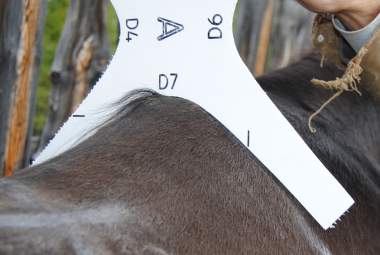 |
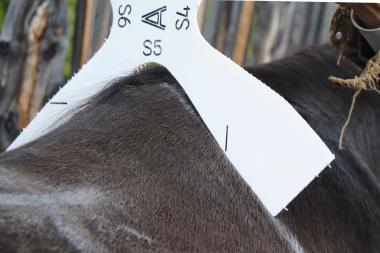 |
|
This card lifts off the horse at the bottom – too wide. |
This card only connects at the bottom and is very high – too narrow. |
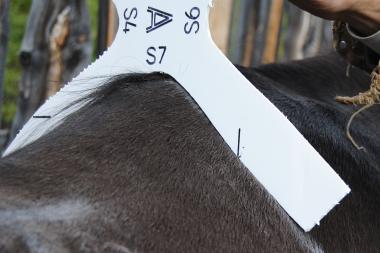 |
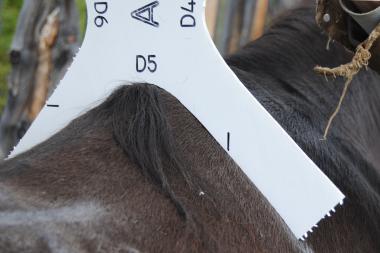 |
| This card is the right size, but only the middle contacts. The bottom and top lift off the horse – wrong shape. | This card has lots of contact and matches the shape. |
4.) Do the same at the B position. The D9 card digs in a little at the bottom, but it was the largest card available at the time. (Larger cards are now part of the system.) It is obviously a much better fit than D7. With the picture we can see that it fits pretty closely, but it is a bit small. That tells us what we need to know. If it was very small, fitting much worse than it does, you can use the C cards at the B position. They won't fit exactly, but they let us get the size better. However, it is very important to communicate that it is a C card size, not a B card size.
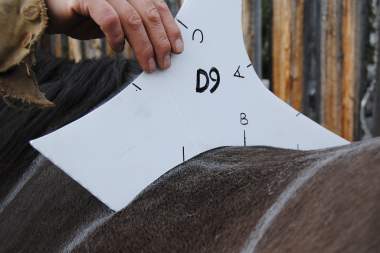 |
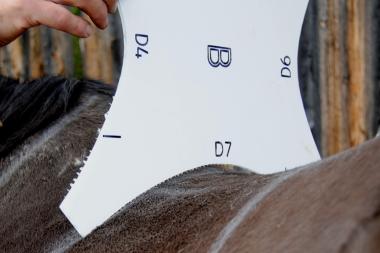 |
5.) Repeat at the C position. Here, the D9 fits pretty well.
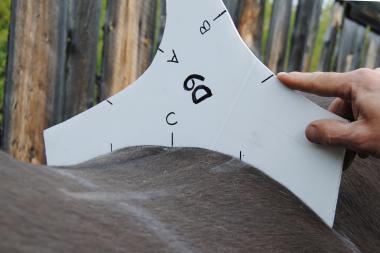 |
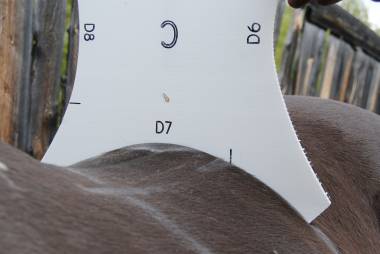 |
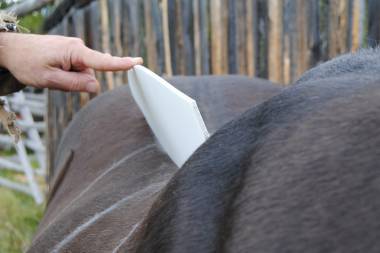
6.) To use the rock cards, measure 3 ½” out from the midline and mark this distance on Lines B and C. (Ignore line A when doing the rock cards.) With the horse’s head in its normal working position (this is crucial), line up the B and C marks on the cards with these marks, making sure that the card is held perpendicular to the horse, not the ground. Choose the shape that fits best. Check both sides. Pictures of the cards in place are helpful. The R6 card is obviously bridging. The R12 (which fit the best) lifts off a bit at the front, less on the right than the left, but fits well down the rest of the back. Pictures of the R9 fit would be helpful here too.
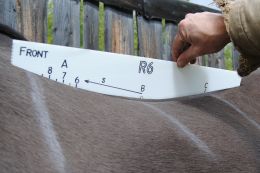 |
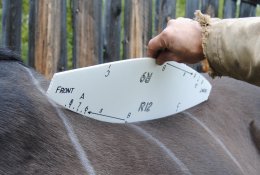 |
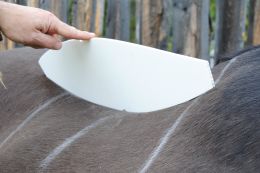 |
7.) Measure the distance between lines A and B, using the scale on the rock card. This tells us how far back his shoulder blades come relative to the low point on his back. The measurement is usually between 6 ½ and 8 inches. In addition, we ask that you measure the distance from the back of the shoulder blade to the point of the hip. This gives us an idea of the comparative length of his back.
Instructions for Making Back Drawings
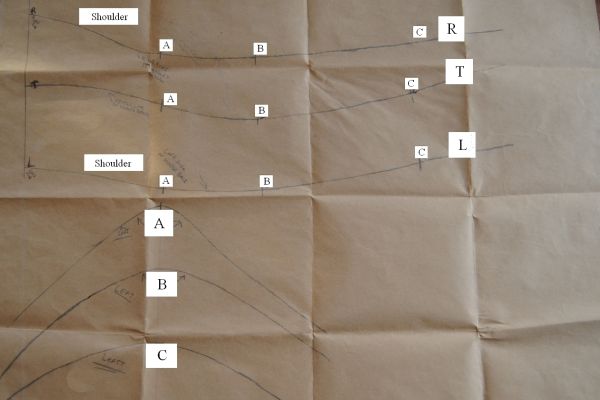
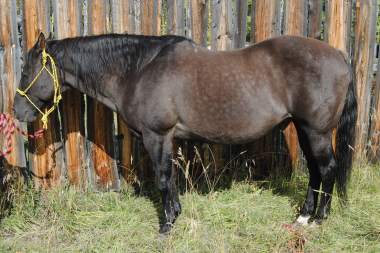
1.) Have the horse stand as squarely as possible on as flat a surface as possible, with his head straight forward and at its normal working height when the measurements are taken. Standing with a hip cocked or a turned, raised or lowered head can change your results.

2.) Make three lines across the horse with chalk or tape to mark where the measurements are taken and to help reference those places to the topline. Line A should be taken just behind the back of the shoulder blade. Make sure you can feel the back of the shoulder blade and that your drawing is behind, and not over top, the shoulder blade. Line B should be placed at the lowest point of the horse’s back and Line C should be placed 8 inches behind Line B.
3.) Use a flexible curve or any other piece of malleable wire to mold to the shape of the horse in these three places and then transfer those shapes onto paper or cardboard. Label them A, B and C as in the example above. Newsprint works well as you need a fairly large sheet of paper to get the full picture. Please double check all shapes since it is very easy for the wires to move between horse and paper. It is also helpful to make a cardboard template and try it back on the horse. This is a good test to see how accurate your back drawing really is. We use these drawings determine how wide apart we want to place the bars, which bar angle would be best at the fork and how much twist we need to put into the bars.
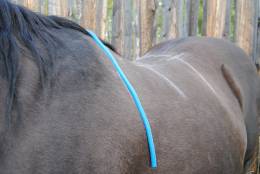 |
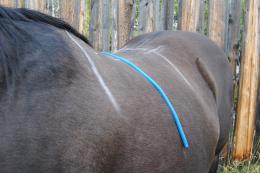 |
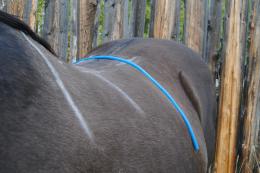 |
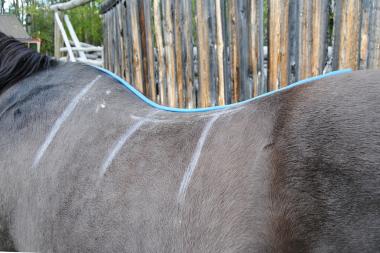
4.) Next, use the wire along the top line of the horse’s back from wither to loin. Label this line T for Topline as in the example above. Mark where lines A, B, and C cross line T. This is important as it tells us where the back of the shoulder and the low point of the bar lie relative to the withers. This gives good information about wither height and how far back the withers go which we use to determine gullet height, hand hole height and the amount of rise in the loin area.
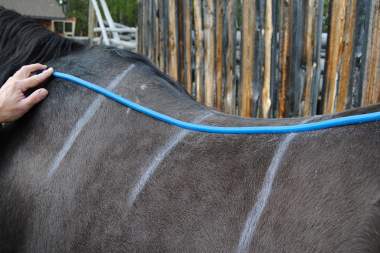
5.) The top line doesn’t necessarily correlate with the amount of rock there is in the horse’s back underneath the bar, which is where it really matters. To get this information, measure 4” out from the midline at positions B and C and mark those points. Then place your wire along the side of the horse connecting these points, continuing straight forward over the shoulder blade and back almost to the hip. Do not try to stay 4" away from the spine ahead of position B as that will mean your measurement will be too high and not under the middle of the bar any more. With the horse’s head in its normal working position (this is crucial) take a drawing along this line. Do this on both sides, marking them L and R for left and right as in the example above. Mark on these tracings where lines A, B and C cross and where the back of the shoulder blade is. This gives information both on rock and on the shoulders – how prominent they are and how far back they come relative to the withers.
6.) We also ask for a couple of measurements. First, measure the distance along the rock line (not along the top line) between line A and line B. This tells us how far back his shoulder blades come relative to the low point on his back. This measurement is usually between 6 ½ and 8 inches. Second, measure from the back of the shoulder blade to the point of the hip. This gives us an idea of the comparative length of his back.
Molds of backs and other methods of measurements
We have been sent the Equimeasure and other molds of backs, and we have used them successfully. The disadvantage to these is the cost and time in purchasing the mold and shipping it to us. They also are too short to give the picture of the length of back that is covered by a Western saddle, though extensions can be purchased for some brands. We have heard that these molds do, on occasion, narrow up when taken off the horse so please double check their accuracy after they have cooled by placing them back on the horse and seeing if they are correct. And they can also change shape in shipping if it is excessively hot. Although they are sold as being reusable, we have heard it is difficult to do so. If you want to use these methods to communicate back shape, we can work with them too.
